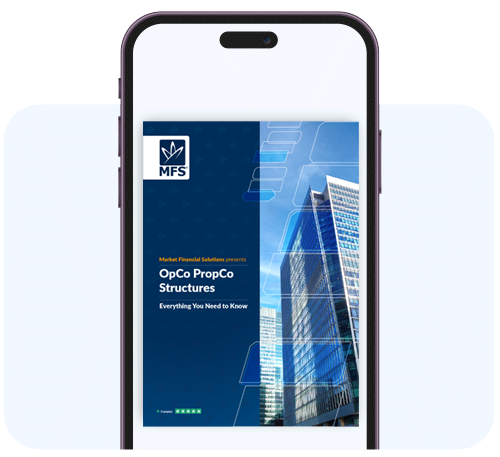The Complete Guide
- Understand the fundamentals of OpCo/PropCo
- Learn how the structure works in practice
- Explore the key benefits
- Assess the risks and challenges
- Real-world applications
Get your free Guide with additional infographics below.

Introduction to OpCo/PropCo Structures
As property investors are forced to adapt to changes in legislation, increased costs, and diminishing yields, the use of OpCo/PropCo structures will likely become more prevalent. But what is OpCo/PropCo exactly, and what are the benefits of OpCo/PropCo structures?
Truthfully, the answers to these questions are relatively straightforward. OpCo/PropCo structures sound more complicated than they are. Although, those who are new to them may find all the intricacies intimidating.
In a nutshell, an OpCo/PropCo structure refers to the separation of a company’s trading business (OpCo) from its property-owning business. It’s created by transferring a property into a property holding vehicle (PropCo) – which is typically a Special Purpose Vehicle (“SPV”).
The difference between OpCo and PropCo entities is easier to understand when the jargon is removed. OpCo is simply an abbreviation for operating company. PropCo stands for property company.
The distinction between OpCo vs PropCo is especially important for certain property-heavy businesses or industries. Keeping the two separate can offer several advantages.

Key Benefits of OpCo/PropCo Structures
To start with, OpCo/PropCo can allow for risk segregation, and asset protection. In this set up, the property assets are shielded from the operational risks of the underlying business. If the OpCo becomes insolvent, is exposed to litigation, or suffers any financial difficulty, the property assets are protected from any of the OpCo’s liabilities.
This structure can also help with raising finance, with OpCo/PropCo financing plans also benefitting from segregation. Each entity can raise capital independently. The PropCo could utilise typical real-estate secured financing options, while the OpCo may borrow without using property as collateral (for a business expansion, for example).
Adding to the financial benefits, utilising OpCo/PropCo could open the doors to a wider pool of institutional investors, funders, or lenders. Some may only be willing to fund real-estate backed opportunities (PropCo), while others will only provide funding for operational purposes such as working capital (OpCo), typically secured against stock or other floating assets.
Generally, with OpCo/PropCo, the PropCo owns the real estate that’s leased back to the OpCo for use. This alone can bring with it tax efficiencies. The rent that the OpCo pays to the PropCo can be deducted as a cost before tax, thereby reducing the amount of corporation tax payable. Tax rules are complicated however, and to see what benefits are available, expert advice should be sought based on the specific structure and circumstances.
There are also a number of operational, or administrative benefits of the OpCo/PropCo structure. It may be more efficient for organisations to split their focus and resources into two distinct areas, rather than try and manage them together. Also, by separating a company’s operational performance(s) from its real estate assets, it may be easer to value each enterprise more accurately.

Difference Between OpCo, PropCo, and HoldCo
While many may have a broad understanding of OpCo/PropCo, there is a third structure which could throw some when it emerges – HoldCo.
Standing for holding company, it may also be referred to as an “umbrella company” or a “parent company[1]”. Where a HoldCo does come into play in our context, it will likely be the entity that ultimately controls and owns both the OpCo and PropCo. But it may not have any day-to-day operations of its own.
Its role could be to provide strategic oversight to the entire enterprise, and ensure effective management of the entire group of companies. Broadly, an OpCo will focus on revenue generation, a PropCo is concerned with asset ownership, and a HoldCo is responsible for oversight and control. It should be noted that an OpCo/PropCo set up does not require a HoldCo, but often has one.

How OpCo/PropCo Structures Work in Practice
To simplify things: a limited company is set up by directors of a trading business. That company is then used to acquire a property, which is (typically) let back to the original trading business. Legally, the property owner and the tenant in this set up are separate entities. But, in practice, they are under common ownership and controlled by the same individuals.
The landlord or lessor (PropCo) leases the property to the tenant or lessee (OpCo). The PropCo will be responsible for servicing any debt secured against the property assets, using the rental income received from the OpCo to do so.
To get the ball rolling on setting up a new OpCo/PropCo operation, the two entities will need to be incorporated at Companies House. Legal experts, financial planners, and the like will be able to help with the details but generally, each entity will need: a company name, registered offices, details of the directors and shareholders, and other key details.
From here, the debt and equity terms, and ownership structure will need to be agreed and finalised. There are a few options available here: the same shareholders can own both the OpCo and PropCo, a holding company can be created, or a trust or private investors can take ownership. The choice made here can affect overall management, profit distribution, tax outcomes etc.
Once the PropCo purchases or otherwise receives (e.g. by transfer) the property, a lease agreement will need to be put in place between the OpCo and PropCo. A solicitor should be involved with drafting the lease to ensure it reflects the requirements of both companies, and is legally binding. Fortunately, there is plenty of optionality here.

Lease Arrangements Between OpCo and PropCo
The leases that can be used for OpCo/PropCos come in many shapes and sizes, but are often simply referred to as operating leases. The right choice for the underlying owners will depend on their circumstances.
A typical example for an OpCo/PropCo may be a long-term lease, which often last for 20+ years. There are also more niche options available, including a full repairing and insuring lease (FRI), step lease, or intercompany lease.
Each of these leases will come with their own rules, and obligations. Take an FRI lease. Here, the tenant (OpCo) takes on the responsibility for all property repairs, and insurance of the building. The idea being that the landlord (PropCo) receives rent with minimum ongoing liabilities, or excess costs.
Having a clearly structured lease in place is crucial from a financing perspective. Lenders will often rely on lease cash flows to underwrite a loan, with a particular focus on interest servicing. They’ll also look at the creditworthiness of both the OpCo and the PropCo. Generally, stronger leases can allow for higher LTVs, and better terms.

Financing in OpCo/PropCo Models
Where lenders can rely on a fixed cash flow stream via an OpCo/PropCo, more attractive terms can be offered, as opposed to what may be available with leveraged finance[2]. However, with the OpCo and PropCo ultimately being grouped together, some lenders will likely analyse both elements to assess viability.
While the exact underwriting parameters will vary between lenders, many will likely look to the OpCo to assess the stability, management, and underlying performance of the business involved. When it comes to assessing the property asset(s) itself (which bridging lenders will typically focus on), they will turn to the property company.
OpCo/PropCo debt structures themselves are split into two distinct areas. As highlighted, PropCo debt is usually secured against property, on a medium-to-long-term basis (commercial mortgages being an example). The focus from the lender/financier’s perspective will be on the property value, rent coverage, tenant creditworthiness etc.
Whereas OpCo debt may be entirely unsecured. Where it is secured, it is typically against the business’s operating assets, such as inventories, and receivables. Here, attention will be given to EBITDA, interest coverage, operating performance etc.
When it comes to maximising loan size, there are a few options available to borrowers, such as improving their credit profile, or combining multiple properties into one loan. With bridging/bespoke finance specifically, borrowers may also be able to boost their loan size with various interest coverage ratio (ICR) tools, such as top-slicing, deferred interest, or retained interest periods.
However, it should be noted that while the relatively complex nature of OpCo/PropCo structures is what provides them with their benefits, they can add complications and risks for lenders. This may make it more challenging to raise funding, meaning specialist lenders are best placed to assess these situations.
For lenders who don’t usually deal with OpCo/PropCos, assessing the risks associated with cross-default, insolvency, and exit strategies may impact their willingness to proceed. For borrowers, it is worth seeking out lenders who are familiar and comfortable with complex property company structures.
Common Structures in OpCo/PropCo Models
Among the most common structures found in OpCo/PropCos is sale and leaseback. Here, typically the OpCo will sell its property to the PropCo, and then the PropCo will lease the property back to the OpCo.
Often though, this kind of set up can also involve a real estate investment trust (REIT). The PropCo in this scenario could itself be structured as a REIT, or sell the real estate asset(s) to an external REIT. The REIT will earn rental income, which is used to cover any business or debt servicing costs, with net profits eventually passed on to shareholders.
Joint ventures (JVs) with institutional investors are also prevalent. A JV can be thought of as a shared ownership structure whereby the operating partner (OpCo) brings with it the business experience and the capital partner (PropCo) delivers capital/funding, and real estate expertise. Often, these kinds of structures are used for development projects, whereby institutional investors provide the funding and expertise needed to get new assets built.
As to be expected, the right structure for individual investors or businesses will depend on their circumstances. Also, each will have its pros and cons that need to be explored before execution.

Sectors Where OpCo/PropCo is Common
In the UK, OpCo/PropCo structures are commonly used in sectors where real estate is a major asset. As such, it’s worth separating real estate assets from the underlying business to benefit from asset protection, tax efficiency, and financing perspectives.
Commercial properties that are, or capable of generating income are commonly held and managed via OpCo/PropCos. This includes:
- Industrial units
- Warehouses
- Offices
- Hospitality properties
- Retail units
- Healthcare hubs and care homes
Companies within each of these sectors (and others like them) will utilise OpCo/PropCos for individual reasons that benefit them.
Broadly, to give a basic example: the OpCo in a retail chain will run the stores, and manage the employees. A hotel Opco will focus on its services, and providing its guests with the best experience possible. A manufacturing hub OpCo will oversee the factory floor and production lines. Meanwhile, the PropCos for all these will own the respective properties, and lease them to the OpCos.

OpCo/PropCo Examples
Among the most well-known OpCo/PropCo examples is McDonald’s, a company once referred to by its founder not as a fast-food chain, but a real estate business[3]. In 1956, the McDonald’s Franchise Realty Corporation was launched, which sought to purchase cheap properties along well-travelled byways for eventual franchising. By 2015, McDonald’s gross property, plant, and equipment totalled $37.7bn on its balance sheet, representing just over 99% of the company’s total assets.
Hilton Hotels offers another example[4]. By the early 2000s, Hilton had a strong presence in over 80 countries, with a portfolio that included Hilton Hotels, Conrad Hotels, Hilton Garden Inn, and other brands. The company was acquired by Blackstone Group in a $26 billion leveraged buyout, which marked a significant shift in growth aspirations and strategic changes, including the implementation of the OpCo/PropCo structure.
Hilton Hotel’s adoption of the OpCo/PropCo structure allowed it to significantly enhance its financial flexibility and operational focus. By separating its real estate holdings from its hotel operations, Hilton was able to accelerate its global expansion, improve its financial performance, and deliver substantial value to its shareholders. This strategic restructuring has positioned Hilton as one of the leading hospitality companies worldwide, with a growing portfolio of hotel brands.
But, we must be mindful that embracing OpCo/PropCo structures comes with risks for certain businesses, and does not always guarantee success. Investors should be mindful of cases such of Southern Cross Healthcare’s[5] when considering their options.
The now insolvent private health and social care service provider planned to use a sale and leaseback strategy to expand following an IPO. But, put simply, as the 2008 financial crisis hit and multiple pressures mounted, the OpCo involved could no longer keep up with its rental obligations[6]. This eventually led to its failure, and highlights the circumstances in which using an OpCo/PropCo structure may not be appropriate.
Potential Challenges & Risks with OpCo/PropCo Structures
While any potential drawbacks associated with OpCo/PropCo will be dependent on the underlying circumstances, there are a few common challenges which may arise fairly frequently across sectors.
To start with, implementing and managing an OpCo/PropCo can be tricky and some organisations may not be able to keep up with that complexity. Also, if relationships are not managed effectively, it can lead to conflicts of interests between the OpCo and the property company. Disputes over lease terms, rental rates, and maintenance may emerge[7].
There may also be fiscal concerns. Separating entities can lead to higher administrative, legal, accounting, and property management costs. Attaining finance may also prove challenging for some. There may be a limited pool of available lenders. Some will be especially cautious when dealing with OpCo/PropCos, given the added cross-default risk.
Property investors need to carefully consider whether an OpCo/PropCo is right for them. Typically, there may be some common scenarios in which it makes sense to engage, and others that may call for an alternative way forward.
If a capital-intensive business wants to scale, an OpCo/PropCo set up could allow for that. The same applies if a firm wants to attract institutional investment or external partnerships.
But a small-scale or startup business would likely struggle with the costs and complexities of an OpCo/PropCo. Certain industries (such as defence) may also have legal or regulatory frameworks that restrict asset separations for oversight reasons.
Furthermore, where operating companies do not need long-term control of the physical assets involved, or if it relies on leased buildings on a short-term timeframe (event companies hiring out venues perhaps), there may be little sense in creating a PropCo. It can add complexity without providing many strategic or financial benefits.

Market Insights
- “The owner of Premier Inn is planning to sell and lease back at least £1b of its mature hotels to fund its future growth. Whitbread said there were signs the property investment market was improving and it had a pool of sites where there was ‘an opportunity to generate additional value’. Whitbread completed the sale and leaseback of two hotels for £56m in the first half of 2025, creating an average yield of just over 4%. It is progressing on the sale and leaseback of a further seven hotels across a variety of regional UK locations.” (The Caterer)
- “2024 is poised to be the fourth consecutive year of record transaction volumes for the self-storage sector. CBRE’s data shows that there has been £510m transacted across the UK so far, with a further £100m under offer that is poised to complete in 2024. The current volume of transactions under offer demonstrates the strong demand for self-storage among REITs.” (CBRE)
- “Project Philadelphia, a sale-and-leaseback portfolio of 25 Asda supermarkets, was purchased by Realty Income for £650 million in the second half of 2024. It included assets in Scotland and Yorkshire.” (CoStar)
Summary & Actionable Takeaways
To reiterate, there are a number of key advantages to setting up an OpCo/PropCo arrangement in the property market, which we believe can be categorised into four distinct areas:
- Risk mitigation: Separating operational and property ownership can help isolate risks, such as market volatility in either sector
- Tax efficiency: Different tax regimes might apply to operational businesses and property holdings, offering tax benefits to separate them
- Capital structures: Property assets often have lower risk and can attract cheaper financing, whereas operational businesses may carry higher risks and different financing structures
- Strategic flexibility: Allows for flexible property management, leasing, or disposal without impacting operational activities
Those who require financing for an OpCo/PropCo are likely to have a better time of it by keeping organised, and understanding lender preferences in this area of the market. For instance, by utilising a special purpose vehicle (SPV) for a PropCo, it could simplify the financing process.
It’s also worth doing enough research to determine which lender would be right for the underlying circumstances. A broker can help here, as their expertise will allow them to identify which specific lenders are comfortable with OpCo/PropCos. On this, it’s also worth doing what one can to improve their creditworthiness. Generally maintaining good financials will make attaining funding easier all round.
As a specialist lender with nearly 20 years of experience behind us, Market Financial Solutions are fully versed on all manner of unique property investment set ups. Not only does this include OpCo/PropCo, but also trusts, share purchase agreements, LLPs, and more.
Many of our specialist finance products can be used with OpCo/PropCo structures. This includes our residential and commercial loans, bridge fusion product, and BTL mortgages.
Also, every single one of our enquiries is responded to within 4 hours. Every deal, regardless of how complicated it may be, is underwritten from day one. Our underwriters thoroughly analyse every element of an enquiry and do everything they can to find a way forward for our borrowers.
We also go above and beyond to make sure our offer works for the borrower’s circumstances. To maximize loan size and remain flexible in the face of affordability issues, we can utilise a range of unique tools at our disposal. Our underwriters have the flexibility to boost loan sizes with deferred interest, retained interest periods, top slicing, and more – so long as it works for the case at hand.
We can get the ball rolling on your case right now if you contact us today. We can be reached online – where our live chat is manned by our underwriters, not a chatbot – over the phone, and via email. Your dedicated underwriter is waiting to hear from you.
[1] https://www.propertytaxservices.co.uk/blog/holding-company-structure/
[2] REF_E_I16_hotel_financing_series_part_3_use_of_opco_propco_structures.pdf
[3] https://www.nasdaq.com/articles/mcdonalds-corporation-real-estate-empire-financed-french-fries-2016-03-06?utm_source=chatgpt.com
[4] https://www.costar.com/article/1631783980/a-closer-look-at-some-hotel-industry-spinoffs?utm_source=chatgpt.com
[5] https://www.ft.com/content/102a1a4a-8ae5-11e0-b2f1-00144feab49a
[6] https://www.theguardian.com/business/2011/jul/16/southern-cross-incurable-sick-business-model
[7] https://bizl.co/blog/opco-propco/#:~:text=The%20landlord-tenant%20relationship%20between,essential%2
Market Financial Solutions are a bridging loan and buy-to-let mortgage provider and are not legal, financial, investment or tax advisers. This document is for informational purposes only and does not, and should not be considered, to constitute legal, financial, investment or tax advice or be relied upon by any person to make a legal, financial, investment or tax decision. Therefore, Investors are encouraged to seek appropriate professional advice. The information in this content is correct at time of writing.
